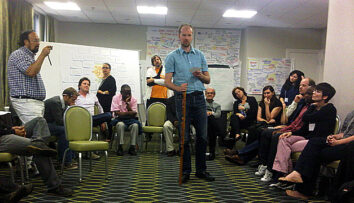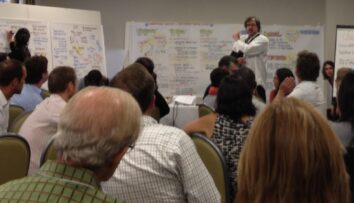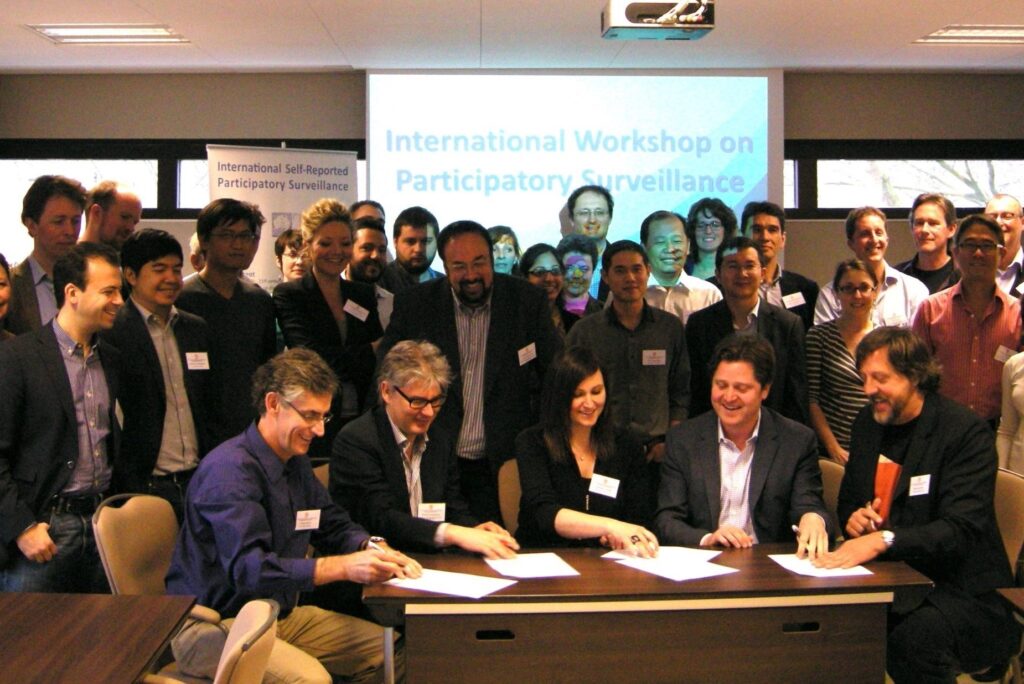IWOPS I
United States 2012
The inaugural event galvanized this innovative approach by bringing together participatory surveillance system implementers from across the globe.
It came about when we were building the online influenza-like-illness (ILI) tracking system in the United States, called Flu Near You. We gathered developers and implementers of other self-reported ILI systems, including Europe’s InfluenzaNet and Australia’s FluTracking systems, so that Flu Near You could be able to “talk” to these similar systems.
As a result, for two days, 50 people gathered, including representatives from the existing systems, trusted friends and colleagues working in disease surveillance from across the globe, along with key partners in creating Flu Near You—the American Public Health Association and Harvard Medical School’s HealthMap. We worked on answering key questions about self-reported disease surveillance to help us with building Flu Near You.
This workshop was originally titled Flu Near You: An International Workshop on Self-Reporting Surveillance, with several objectives:
- Sharing learning, experiences and perceptions about the utility of self-reported ILI systems
- Tackling the challenges and the science of participatory surveillance such as case definitions
- Exploring the opportunities to improve user engagement, data sharing and visualization
- Planning for individual regional systems to operate as an integrated global resource
- Exploring the broader application of this approach beyond influenza
Out of the workshop came the decision to hold two follow-up workshops, one hosted by InfluenzaNet and the other by FluTracking. These later workshops became IWOPS II and IWOPS III.



IWOPS II
Netherlands 2013
Participants explored self-reporting for all emerging infectious diseases by creating a standardized list of symptoms to track both human and animal health.
The main objective of this second workshop, which happened a year after the first, was for each system to present research on how people used the data from their system. Other areas addressed at this convening included:
- Communication strategies
- Policy experiences
- How to move participatory surveillance into other regions of the world
- New techniques and instruments (e.g., apps and social media)
- Creating media attention, particularly among science journals and public health policymakers
As a result of this meeting, an agreement was signed among the three ILI systems (Flu Near You, InfluenzaNet, and FluTracking) to create an application programming interface (API) that would allow direct data sharing among the three systems to gain a global picture of ILI. This effort became Global Flu View.
The other major outcome of IWOPS II was an agreement on a list of 12 symptoms, such as fever and chills, coughing or sneezing, sore throat, and runny nose, that should be recorded by every participatory surveillance system—both current systems or any others that were going to be built. A common data format as well as system location by longitude and latitude were also agreed upon.


IWOPS III
Australia 2016
Our expanded community of practice focused on the challenges of data sharing, privacy and ethics. Updates on these and several other key issues were published as a supplement with the Journal of Medical Internet Research.
At this workshop, the group focused on:
- Recruitment and participation, as these areas were ongoing challenges for many of the current systems
- Adding diagnostics to help validate the self-reported data
- Using the self-reporting tool for contact tracing for ebola (given the 2014 West Africa crisis) and other emerging health threats
- New applications of this approach, including mass gatherings and One Health
- The promise of The Internet of Things and how wearable devices, proximity sensors, modeling and digital communications could advance participatory surveillance
- The opportunities of open data, data sharing, and developing data dictionaries
- The challenges of ethics and privacy
We left that workshop feeling it would be important to hold an IWOPS IV focused on building One Health participatory surveillance systems in every country, and supporting that effort by developing data standards that would permit greater data integration and across human, animal and environmental health—and permit systems to eventually communicate across the globe. Welcome to IWOPS IV!


